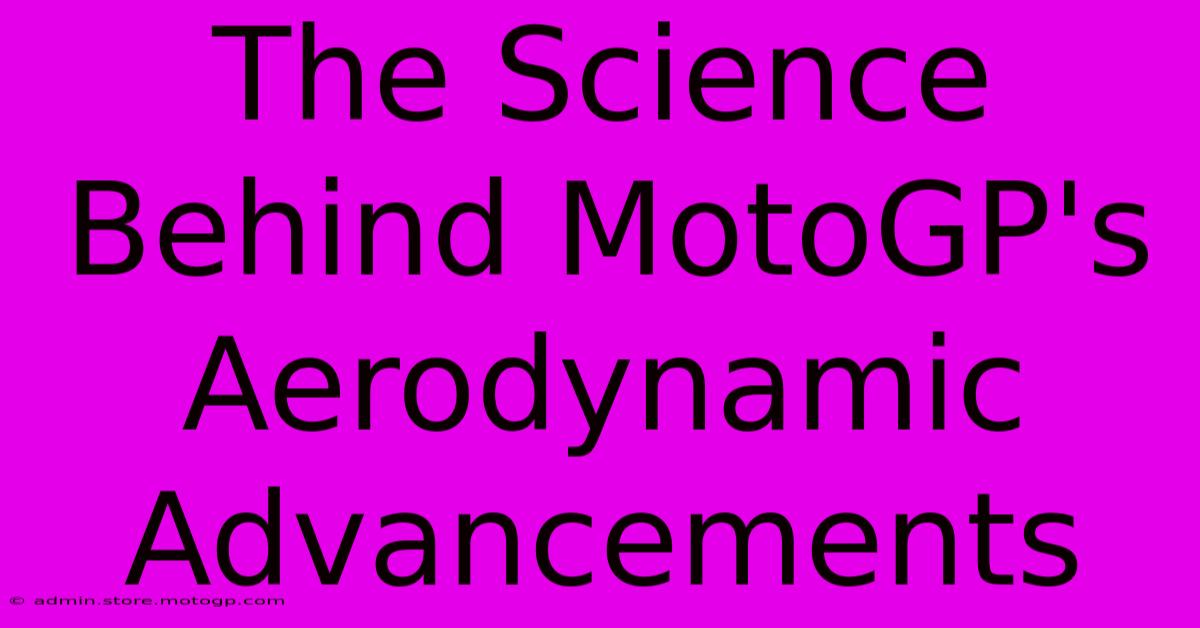The Science Behind MotoGP's Aerodynamic Advancements

Table of Contents
The Science Behind MotoGP's Aerodynamic Advancements
MotoGP, the pinnacle of motorcycle road racing, is a relentless pursuit of speed and performance. A crucial element in this quest is aerodynamics. The science behind the aerodynamic advancements in MotoGP is complex, constantly evolving, and profoundly impacts rider performance and lap times. This article delves into the key principles and technologies shaping the cutting-edge designs we see on the track.
Understanding the Fundamentals: Drag and Downforce
The fundamental principles governing MotoGP aerodynamics revolve around two opposing forces: drag and downforce.
-
Drag: This is the resistance a motorcycle experiences as it moves through the air. Reducing drag is crucial for maximizing top speed. Designers achieve this through streamlining, minimizing surface area, and optimizing the airflow around the bike.
-
Downforce: This is the force pushing the motorcycle downwards, increasing grip and stability at high speeds, especially during cornering. Generating downforce is paramount for achieving faster lap times, as it allows riders to lean into turns more aggressively without losing control.
Key Aerodynamic Components and Their Roles
Modern MotoGP bikes are masterpieces of aerodynamic engineering, incorporating several key components to manage drag and downforce:
-
Fairings: The bodywork, or fairing, is meticulously shaped to channel airflow smoothly over and around the motorcycle, minimizing drag and directing airflow to generate downforce. The design is highly sophisticated, incorporating winglets, spoilers, and other aerodynamic devices.
-
Winglets: These small, wing-like structures, often located on the front fairing and sometimes on the side fairings, are designed to generate downforce. They work by creating a pressure difference above and below the winglet, pushing the bike downwards.
-
Spoilers: Similar to winglets, spoilers generate downforce. They are typically larger and placed strategically to manage airflow separation and reduce drag at high speeds.
-
Aerodynamic Appendages: Beyond winglets and spoilers, teams constantly experiment with smaller appendages and ducts. These are carefully placed and shaped to fine-tune airflow, maximizing downforce and minimizing drag in specific areas of the bike. These additions are often subtle, demonstrating the meticulous attention to detail within the sport.
Computational Fluid Dynamics (CFD): The Heart of Development
The development of MotoGP aerodynamics relies heavily on Computational Fluid Dynamics (CFD). This sophisticated simulation technology allows engineers to model airflow around the motorcycle virtually, allowing them to test different designs and modifications without physically building prototypes. CFD is crucial for optimizing every aspect of the bike's aerodynamic profile, predicting performance gains, and minimizing testing time.
Wind Tunnel Testing: Validating Simulations
While CFD offers invaluable insights, wind tunnel testing remains essential. This allows engineers to validate the CFD predictions in a controlled environment. Wind tunnels provide real-world data on airflow patterns, drag coefficients, and downforce levels. These results then inform further refinements of the designs, creating a continuous feedback loop between simulation and physical testing.
The Ongoing Evolution of MotoGP Aerodynamics
The quest for aerodynamic advantage in MotoGP is never-ending. Teams continually push the boundaries of design, constantly exploring new technologies and innovations to gain even the smallest performance improvements. The interplay between CFD, wind tunnel testing, and on-track performance data drives the continuous evolution of these complex and sophisticated aerodynamic systems, making MotoGP a fascinating showcase of cutting-edge engineering.
Conclusion
The science behind MotoGP's aerodynamic advancements is a captivating blend of theoretical principles, advanced simulation techniques, and rigorous testing. The constant pursuit of performance pushes the boundaries of what's possible, resulting in ever-more sophisticated and impressive machines. The future of MotoGP aerodynamics promises further innovation, potentially leading to even more spectacular speeds and breathtaking displays of skill and engineering prowess.

Thank you for visiting our website wich cover about The Science Behind MotoGP's Aerodynamic Advancements. We hope the information provided has been useful to you. Feel free to contact us if you have any questions or need further assistance. See you next time and dont miss to bookmark.
Featured Posts
-
Cota Parking Your Key To A Successful Race Day
Feb 21, 2025
-
Moto Gp Qualifying Heart Stopping Moments
Feb 21, 2025
-
Gp Results The Power Of Information
Feb 21, 2025
-
Us Gp Concerts Your Ticket To Fun
Feb 21, 2025
-
The Formula 1 Shuttle Your Vip Pass
Feb 21, 2025
